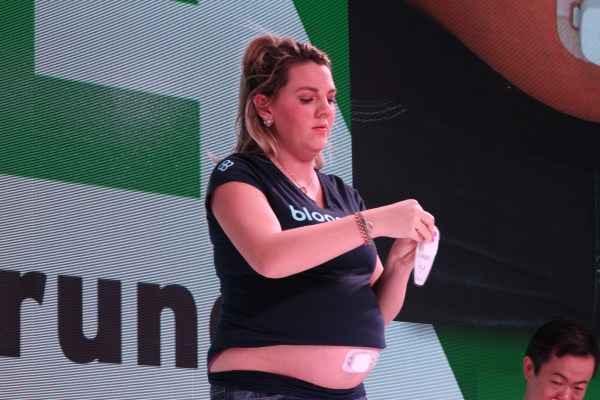Today’s wearables are only scratching the surface of what we can learn about our health. BloomLife, makers of a clinically validated wearable for pregnant mothers, wants to dig deeper when it comes to the health of the baby and the mother during pregnancy. The company demonstrated its wearable onstage today at Hardware Battlefield at CES.
Women experience all kinds of crazy sensations during pregnancy. But to date, there hasn’t been any technology that continuously tracks information about the mother or the fetus over the course of months. Because of this, mother’s aren’t sure how to interpret the signals their bodies are sending them, costing extra time, money, energy and anxiety.
That’s where BloomLife comes in.
BloomLife is a wearable device, worn with a strap around the belly, that lets pregnant women track the muscle contractions in her uterus. The electronics are housed in a little pod, which connects to a disposable patch worn on the abdomen. Women can wear the BloomLife all day, for a few hours to check in each night, or throughout the night, based on their own needs. Given that the device is meant to track contractions, it’s most useful for the final trimester.
By looking at a long-term history of contractions and measuring the frequency and severity of those contractions, pregnant women can have a better idea of their progress.
For example, many pregnant women experience Braxton Hicks contractions. BH contractions may feel similar to labor, and they are a common part of most pregnancies. However, these early contractions often don’t increase in intensity or occur more frequently like labor contractions do.
Since BloomLife offers a timeline to track these contractions, women are able to better interpret what’s going on in their bodies, from gas to early contractions to labor.
[gallery ids="1435009,1435003,1435000,1434997,1434998,1435001,1434996"]
For now, BloomLife doesn’t offer any diagnostic tools — the product will not tell you definitively if you are going through Braxton Hicks contractions, labor contractions, or otherwise. However, BloomLife lets you get a better understanding of the body during pregnancy, helping parents make better decisions when that odd sensation hits.
With enough data, BloomLife can move into diagnostics and help mothers detect complications, and/or determine the difference between early labor and real labor, among other things.
BloomLife plans to charge on a subscription basis ($149 for first month, $249 for second month, and $299 for third month). This subscription includes the re-usable pod, as many disposable patches as you need, and full access to the software.
On average, most pregnant women who have tested BloomLife use it for 7 to 8 weeks.
BloomLife plans on releasing the device commercially in February of 2017.
You can check it out here.
